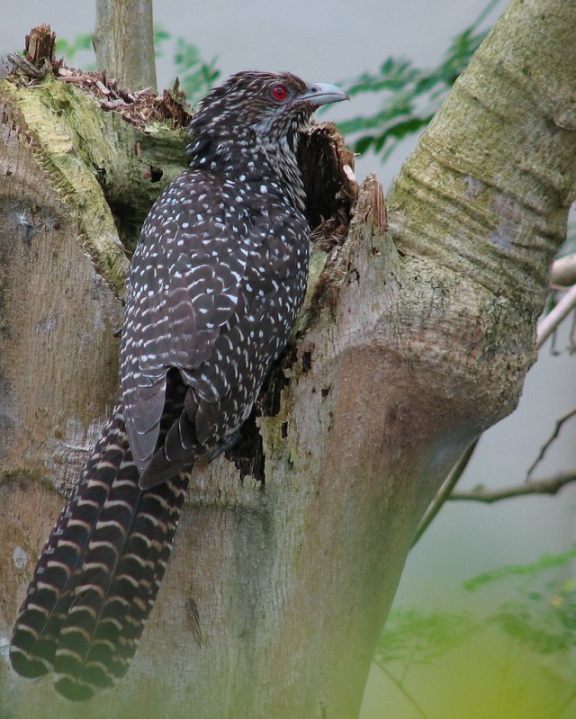- Asian Koel
image_width = 240px
image_caption = Female
status = LC
status_system = iucn3.1
regnum =Animal ia
phylum =Chordata
classis = Aves
ordo =Cuculiformes
familia =Cuculidae
genus = "Eudynamys"
species = "E. scolopaceus"
binomial = "Eudynamys scolopaceus"
binomial_authority = Linnaeus,1758
syonyms ="Eudynamis honorata" "Eudynamys scolopacea"The Asian Koel ("Eudynamys scolopacea"), formerly also Common Koel, is a member of the
cuckoo order ofbird s, theCuculiformes , which also includes such birds as the roadrunners, the anis, andcoua s. It is found from southern Asia, China, and into Australia. The subspecies found in the Philippines is sometimes known as the Philippine Koel. Like many cuckoos, it lays its eggs in other birds' nests.The word "koel" also means "
nightingale " in India because of the Indian Koel's melodious call. It is also colloquially known as the Rainbird or Stormbird in easternAustralia , as its call is supposed to foreshadow rain.Description
The Asian Koel is a large, long-tailed, cuckoo at 45 cm. The male is bluish-black, with a pale green bill, rich red eyes, and grey legs and feet. The female is brownish above and whitish below, but is heavily striped and spotted brown on the underparts and white on the upperparts. She has an olive or green beak and red eyes.
Koels are very vocal, with a number of different calls.
ubspecies
Distribution and habitat
The Asian Koel is a bird of light woodland and cultivation. It is a mainly resident breeder in tropical southern
Asia fromIndia andSri Lanka to southChina andAustralasia . Birds at the fringes of the range, such as much of Eastern Australia, and on high ground are summer visitors, migrating to warmer areas in winter. They have great potential in colonizing new areas. They first arrived in Singapore in the 1980s and became very common birds.Behaviour
It is a
brood parasite , and lays its single egg in the nests of a variety of birds, including theJungle Crow , cite book|author=Goodwin D.|year=1983|title=Crows of the World |publisher=Queensland University Press, St Lucia, Qld|id=ISBN 0-7022-1015-3]House Crow and various species ofhoneyeater s. InSri Lanka it has been noted to parasitize only the Jungle Crow until the 1880 and only later shifted to the House Crow. [Phillips, W. W. A. (1948). Cuckoo problems of Ceylon. Spolia Zeylanica 25:45-60] May also parasitizeBlack-headed Oriole s. [Sethi, V. K., Saxena, V and Bhatt, D. 2006. An instance of the Asian Koel "Eudynamys scolopacea" destroying the nest of a Black-headed Oriole "Oriolus xanthornus". Indian Birds 2(6):173-174] The young Koel does not always evict its host's chicks, and initially calls like a crow. The adult koels however may not be leaving their offspring alone entirely:This behaviour of brood parasites feeding their young has been noted in several other species. [Janice C. Lorenzana and Spencer G. Sealy (1998) Adult brood parasites feeding nestlings and fledglings of their own species: A review. J. Field Ornithol., 69(3):364-375 [http://elibrary.unm.edu/sora/JFO/v069n03/p0364-p0375.pdf] ] The note alluded to byRichard Lydekker is probably that of A. O. Hume which was noted by Fulton in 1904. [Fulton, R. 1904. The Kohoperoa or Koekoea, Long-tailed Cuckoo (Urodynamis taitensis): an account of its habits, description of a nest containing its (supposed) egg, and a suggestion as to how the parasitic habit in birds has become established. Trans. N. Z. Inst. 36:113-148.]Diet
The Asian Koel is omnivorous, consuming a variety of
insect s,caterpillar s, eggs and smallvertebrate s. Adults predominanty feed onfruit . It has occasionally been known to take eggs of small birds. [Uttangi, J. C. 2004. Robbing of eggs by female Koel, from the nest of Red-whiskered Bulbul ("Pycnonotus jocosus"). Newsletter for Birdwatchers 44 (5): 77.]Gallery
Notes
References
* Database entry includes justification for why this species is of least concern
* Grimmett, Richard; Inskipp, Carol, Inskipp, Tim & Byers, Clive (1999): "Birds of India, Pakistan, Nepal, Bangladesh, Bhutan, Sri Lanka, and the Maldives". Princeton University Press, Princeton, N.J.. ISBN 0-691-04910-6
* Slater, Peter & Calaby, John H. (1970): "A field guide to Australian birds (Non-passerines)". Rigby, Adelaide. ISBN 0-85179-102-6External links
* [http://home.tiscali.nl/jvanderw/malaysia02/sounds/asiankoel.mp3 Song of the Indian Koel]
* [http://ibc.hbw.com/ibc/phtml/especie.phtml?idEspecie=2452 Asian Koel videos on the Internet Bird Collection]
Wikimedia Foundation. 2010.

